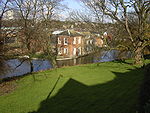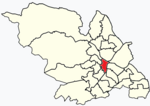Sheffield General Cemetery
1836 establishments in EnglandCemeteries in SheffieldCommonwealth War Graves Commission cemeteries in EnglandGrade II listed buildings in SheffieldLocal Nature Reserves in South Yorkshire ... and 2 more
Porter BrookUse British English from March 2021

The General Cemetery in the City of Sheffield, England opened in 1836 and closed for burial in 1978. It was the principal cemetery in Victorian Sheffield with over 87,000 burials. Today it is a listed Landscape (Grade II*) on the English Heritage National Register of Historic Parks and Gardens. It is also a Local Nature Reserve. It is owned by the City of Sheffield and managed on behalf of the city by a local community group, the Sheffield General Cemetery Trust.
Excerpt from the Wikipedia article Sheffield General Cemetery (License: CC BY-SA 3.0, Authors, Images).Sheffield General Cemetery
Stalker Walk (Porter Brook Path), Sheffield Broomhall
Geographical coordinates (GPS) Address Nearby Places Show on map
Geographical coordinates (GPS)
| Latitude | Longitude |
|---|---|
| N 53.369166666667 ° | E -1.4872222222222 ° |
Address
Stalker Walk (Porter Brook Path)
Stalker Walk (Porter Brook Path)
S11 8JJ Sheffield, Broomhall
England, United Kingdom
Open on Google Maps









